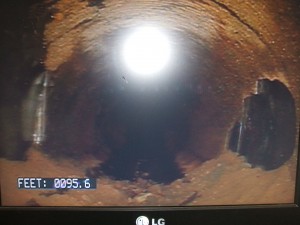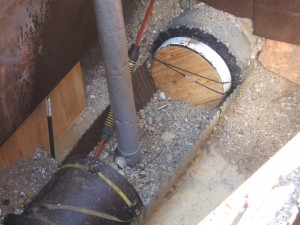July 2010 Vol. 65 No. 7
Features
CIPP Lining A Cost-Effective Solution For Corroded Concrete Pipes

Utility districts understand that water and sewer pipes deteriorate over time. This is especially true for concrete pipes. Popular for water systems, pre-stressed concrete cylinder pipes have also been installed in sanitary sewer systems. But an inherent issue with sewage is the build-up of hydrogen sulfide (H2S) gas, which can have far-reaching effects that may not be noticeable until a major problem occurs.
The Caledonia (WI) Utility District faced such a problem with a section of pipe. As they investigated the issue, their findings could be helpful for any sewage district that uses concrete pipe for sewage collection.
The Village of Caledonia is a quiet community of 25,000 residents approximately 20 miles southeast of Milwaukee, WI. Tucked between I-94 and the city of Racine, the village has no treatment facility. Instead, according to Robert Lui, manager of Caledonia’s Utility District, all 175 miles of pipe are used for collection. The pipes empty their effluent into the treatment facility in Racine. Installed in 1988, the collection system uses pre-stressed concrete cylinder pipes that range from eight to 52-inches in diameter, and includes two lift stations. Most of the pipe operates on gravity flow, but the last 10 miles is a force main operating at 20 – 22 psi, Lui said.
Problem arises
In June 2008, a 10 by 14-foot sinkhole appeared on Michigan Boulevard, along Racine’s lakefront. Because the hole occurred above a portion of the force main, Racine officials contacted Caledonia’s Utility District. Inspection revealed a large hole in the force main, and that a chunk of the pipe and a large amount of surrounding sand had washed down the main. (There was no apparent exfiltration, Lui added.)
Caledonia’s staff cleaned out what they could from the broken pipe, ultimately removing about five yards of sand, dirt and debris. But they stopped when their equipment encountered a large boulder that was protruding into the pipe. The district turned to Reesman’s Excavating & Grading Inc. from Burlington, WI, to perform an emergency repair of the pipe and pave over the hole in the road. “That was a temporary patch to buy some time to figure out what we were going to do with it,” Lui said.
An engineering firm brought in to review the matter recommended either pipebursting or relaying the entire section of damaged pipe. Both cost estimates were high, Lui said, so the Utility District turned to Foth Infrastructure & Environment LLC, of Milwaukee for further analysis. Project Manager Michele Klappa-Sullivan, P.E, said her engineers realized immediately that pipebursting would not work on the reinforced concrete pipe. Plus, the sewer pipe lies precariously close to two 60-inch water mains. “We quickly determined that we needed to come up with a different solution,” Klappa-Sullivan said, “and we needed to find out what the rest of the pipe condition was.”
The Utility District asked Visu-Sewer Inc., of Pewaukee, WI, to televise the section of pipe and provide some recommendations. Televising showed that the hole in the pipe was just the beginning, Lui said. Four spots in the pipe were bad enough to warrant replacement, along with other sections that were deteriorating.

More than a hole
While the sinkhole was the most obvious problem, said Keith Alexander, president of Visu-Sewer, televising revealed that hydrogen sulfide gas had eaten through the pipe in numerous places. The worst spot on the 20-year-old pipe caused the cave in and sinkhole.
“We asked, ‘Can this thing be relined, or is it too bad?’ ” Lui said.
Visu-Sewer recommended replacing the worst portions of the pipe and rehabilitating the rest with CIPP lining by National Liner. “The cost to do the spot relays and relining was substantially cheaper than full pipe replacement,” Lui pointed out.
For Visu-Sewer, this project offered the firm an opportunity to showcase its expertise and experience. “We were confident we could get it done on time and deliver a good product,” Alexander said.
Concrete pipe is common for water systems, but is susceptible to corrosion when used in sanitary systems. If conditions are right, the sewage can turn septic, Alexander said. Sulfide gas will build up, causing the concrete to deteriorate.
The process began with Reesman’s Excavating creating digging access points to the pipe. One crew from Visu-Sewer cleaned and televised the pipe. Afterward, a second crew arrived to install the CIPP pipe. Because they were working with a force main, Alexander said, the firm incorporated end seals in the pipes.
“In a gravity system, everything flows through randomly,” he explained. “But with force main, you have pressure pushing fluids back behind the liner, causing problems. A seal at the end doesn’t allow any fluids to go behind the liner.” Visu-Sewer repaired a total of 2,105 feet of 30-inch force main and televised an additional 1,200 feet of pipe.

Challenges
While working on the spot relays, flow was diverted into pipes owned by the city of Racine. But even that proved to be a challenge. They were diverting from a 30-inch force main into a 12-inch pipe, Lui said, which meant they could divert only during low-flow conditions.
If storms were predicted, Lui called Visu-Sewer or Reesman’s, and in a matter of three or four hours, the connection would be closed. “I have to give the utmost credit to Visu-Sewer and Reesman’s for suggesting something like this,” Lui said. It involved some additional expense, but allowed them to return to their force main on a short notice. Best of all, there were no basement backups.
“We had absolutely zero flow issues during the whole duration of the project,” Lui observed. “It was a very well thought out and managed project that went very smoothly.”
The pipe had to be closed and reopened four times due to wet weather, Alexander added.
Klappa-Sullivan credits Visu-Sewer and Reesman’s Excavating for carefully working around sensitive areas near Racine’s water treatment plant. “Because one of the sections was longer than the other,” she said, “we needed to avoid digging anywhere near the main water feeds and the backwash filter feed from the treatment plant.” A project like this normally would entail four or five access points, she said, but they kept the number to three to minimize holes in the road.
Adding to the complexity was that the section of pipe included two bends that, on paper, were 45 degrees, but which actually were “more like sweeping 90s,” Alexander pointed out. They even got stuck in one bend for several hours, he said. To compensate, Visu-Sewer’s crew increased the column height. That increased the water head, which in turn pushed the liner through the bends.

Having the proper liner made a big difference, Klappa-Sullivan said, adding that they needed a liner that was able to stand up to all the ground forces. “The structural liner that Visu-Sewer used, which comes from National Liner, is as good as any pipe you would put in the ground.”
Public works projects, especially those involving roads, tend to generate calls from citizens. This project was no different, though response was minimal. Lui said he received a couple of calls concerning Visu-Sewer’s trucks running overnight. Klappa-Sullivan added that Visu-Sewer, by limiting itself to just three access points, helped in this regard. “The city of Racine was pleased at how it worked out,” she said.
Valuable lessons
Alexander said this rehabilitation project offers valuable lessons for utility districts that use reinforced concrete pipe for sanitary sewage. “Make sure you inspect the pipeline on a three- to five-year rotating basis,” he said, “and document those segments that might be of concern. Inspect them more often if you suspect a problem.”
He recommends that utilities look for contractors with the expertise in this area. These are challenging projects, he said. An experienced contractor will make sure the construction process is organized and flows smoothly.
For more information:
Visu-Sewer, (800) 876-8478, www.visu-sewer.com
National Liner, (281)874.0111, www.nationalliner.com
Reesman’s Excavating & Grading Inc., www.reesmans.com
Foth Infrastructure & Environment LLC, 414-336-7900, http://foth.com/fothweb




Comments